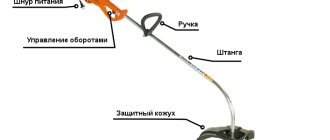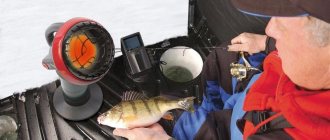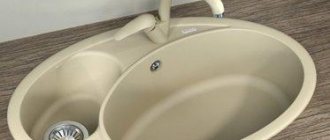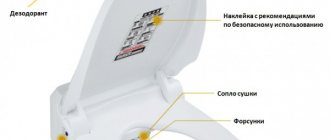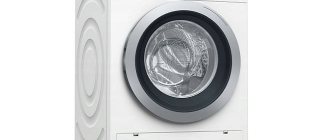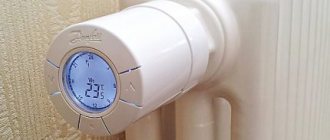Home » Water heating » Selecting a pump for heating a private house
The pump is one of the main components of a high-quality heating system, as it ensures efficient and uninterrupted operation for a long time.
The operation of the device directly affects the reduction of fuel consumption, and also ensures uniform heating of batteries and radiators. In addition, installing a pump will solve some problems that arose during self-installation of the heating structure.
Heating pump for a private house
Each individual case depends on an individual approach, so you need to understand how to choose a pump for heating a private home.
One of the most popular models of equipment is a circulation device, which is divided into a design with a “dry” and “wet” rotor.
Features of a dry rotor heating pump
The device received its name due to its main property - the absence of contact with liquid, as a result of which the device remains dry. In this case, air cooling is used.
Due to air operation, a fairly high noise level is created. Therefore, its use is strictly limited.
Dry rotor pump design
The main advantage of this pump is its high performance, the value of which is several times higher than other models. However, the unit requires regular maintenance.
Design Features
A water pump for home heating is one part of the circuit; its components also include a boiler, radiators, various filters, etc. Operational efficiency can only be ensured by the coordinated operation of all these elements.
At the same time, water pumps are very often of the built-in type and are included with the heating boiler. However, this option, which undoubtedly has advantages in the form of a reliable design, its compactness and excellent performance characteristics, turns out to be too expensive for the average user.
That is why the most popular on the market among consumers are water circulation pumps, the installation of which occurs separately from the installation of the boiler. Choosing to install a stand-alone unit thus has clear advantages, including:
- acceptable price;
- the possibility of modernizing the current system;
- ease of dismantling if repair or maintenance is necessary;
- ease of installation work.
For modern heating systems, the most common are two types of water pumps:
- “dry”, in which complete isolation of the engine from the circulating fluid is ensured. This property is acquired thanks to special seals that are responsible for the tightness of the motor. Dry rotor systems are most often used to heat industrial areas;
- “wet”, in which the rotor drive structure is driven by the fluid circulation in the system. This type of pump, with some drawbacks in the form of a lower efficiency indicator, has nevertheless gained a stable primacy in the use in heating systems of private households. The high rating of the device on the market is explained by a number of positive characteristics: affordable price, relative noiselessness and sufficient simplicity.
Circulator with wet rotor
This type of device is cooled by liquid, so it makes virtually no noise during operation. This advantage more than offsets the disadvantage of a low level of efficiency.
A pump with a wet rotor is very often used for installation in residential premises. If the installation is installed in a boiler room, the noise level will be significantly reduced.
After one of the device types has been selected, we proceed to the selection of the following technical characteristics and parameters.
Types of circulation pumps
Experts distinguish between two main types of circulation pumps installed in local heating systems. Each of them requires careful consideration.
Dry circulation pumps.
The design of dry circulation pumps eliminates contact of the electric motor rotor with the pumped water. The impeller in this case is separated from the rotor by rings of the mechanical seal.
The materials used for them are:
- high-strength mixtures based on pressed carbon;
- stainless steel;
- wear-resistant ceramics;
- aluminum and tungsten oxides.
The rings are pressed against each other by springs. When moving, they rub tightly against one another. The thinnest film of water entering the gap serves as an additional sealing element of the structure. Old pumps used a stuffing box instead of a mechanical seal, which had to be periodically tightened or refilled as it wore out to restore the original tightness. The ends of modern models do not require repair for 3 years or more.
Design of a circulation pump with a dry rotor.
1. Engine fan. 2. Motor housing with cooling fins.
3. Sealing gland. 4. Impeller.
5. Pump housing.
Features of operation of dry-type circulation pumps:
- high efficiency, reaching 80%;
- increased noise level, requiring installation of equipment in a separate room;
- strict requirements for minimizing the content of suspended solids in water, leading to abrasive wear of seals;
- inadmissibility of prolonged idling without contact with liquid.
Design options and installation positions for dry pumps.
Horizontal pumps
Horizontal pumps have a classic installation option, in which the impeller and motor are located on the same level. Their inlet pipe is located in the end part, and the discharge pipe is on the side surface of the housing.
Vertical pumps
Vertical pumps are distinguished by the position of the engine above the working part. Their inlet and outlet pipes usually have the same diameter and are located on the same horizontal axis.
Block pumps
Block pumps are characterized by a compact design. The electric motor and impeller are often mounted in one housing. They are characterized by the end location of the receiving fitting and the radial direction of the discharge pipe.
Dry circulation pumps are practically not used in home boiler rooms, since in this case circulation pumps with a wet rotor are best suited.
Wet circulation pumps
A distinctive feature of wet pumps is the direct contact of the electric motor rotor with the pumped liquid. In this case, water plays the additional role of lubricating rubbing surfaces and cooling the engine. In this case, live parts are protected by a glass made of stainless materials, separating the rotating shaft from the stator. Ceramic and graphite are actively used in the manufacture of the rotor. The body is usually made of bronze, brass or cast iron.
Features of wet type circulation pumps:
- almost silent operation;
- minimal maintenance;
- long service life;
- low efficiency, which rarely reaches 50%.
Modern models have a modular structure that facilitates inspection and repair. The supply pipes are attached to the pump using threads or flange connections. Due to the need for a uniform supply of cooling water to the bearing units, equipment of this type is almost always mounted in a horizontal position.
Design of a heating circulation pump with a wet rotor
1. One-piece wet rotor cup. 2. Ceramic shaft.
3. Wet rotor. 4. O-ring.
5. Pump impeller. 6. Cover.
Pump power in the heating system of a private house
As you know, electricity consumption directly depends on the choice of device power, but from a practical point of view, disagreements may arise. This is explained by the fact that a device with more power can process a larger volume of liquid while using low speeds.
In addition, if you use the installation at full power, the motor will overheat and fail prematurely. Therefore, the issue of choosing the appropriate pump power remains relevant.
Circulation pump
Before choosing a model of a specific power, it is necessary to study the technical characteristics of the heating system for which it is purchased. The main parameters can be:
- Power of heated equipment.
- System type.
- Design capacity.
- Pipe diameter.
In order to determine the battery capacity, you need to know its type (aluminum, cast iron, etc.), the length of the pipes and their diameter, find out the necessary data on their capacity and carry out the appropriate calculations.
The obtained data must be reported to a specialist, and he will help you choose the optimal power option.
What pumps are used in heating systems?
The heating circulation pump serves to maintain the required pressure in the system. It is a housing in which the electric motor rotor and impeller are placed. The rotation of the impeller creates excess fluid pressure at the outlet and vacuum at the inlet. Due to this, the coolant moves. This equipment comes in two types:
- With a “dry” rotor. In this design, the impeller in contact with water is isolated from the electric motor rotor using seals.
- With a “wet” rotor, when both the impeller and the rotor are placed in the coolant. It serves to lubricate and cool the engine.
Most often in everyday life, a water heating pump with a wet rotor is used. Its advantages are as follows:
- Almost silent operation is especially important, because often such a pump is installed in close proximity to residential premises;
- The design does not require maintenance;
The diameters of the pipeline with which the pump is compatible and the length of the device body also differ. Standard heating piping sizes in our area are 1 inch (25 mm) and 11/4 inches (32 mm). Typically, household “wet” type circulation pumps are available in lengths of 130 or 180 mm.
Heating system design
The design of most heating systems can function without a pumping unit, but in this case, high-quality heating is out of the question.
There is a temperature difference between the top and bottom of the battery, which affects the uniformity of thermal energy distribution. If you use a pump, you can save about 500 cubic meters of gas annually, because the unit significantly improves circulation in the structure.
Heating pump installation diagram
You can connect the cooling unit via a relay, which will turn it on and off at certain intervals. The boiler will heat the water when it is turned off, and when the pump is turned on, warmer liquid will enter the heating circuit.
The correct selection of a pump for heating a private home will allow residents to feel the comfort of the purchase and experience visible energy savings.
Main advantages of circulation pumps
The device has many positive aspects, including:
- provide good heat transfer in metal elements of the heating structure;
- the ability to independently change the temperature regime in a private home;
- in the absence of residents, you can set the lowest temperature conditions and save on the energy source;
- ensures the fastest heating of pipes and radiators.
Heating pump for a private house


